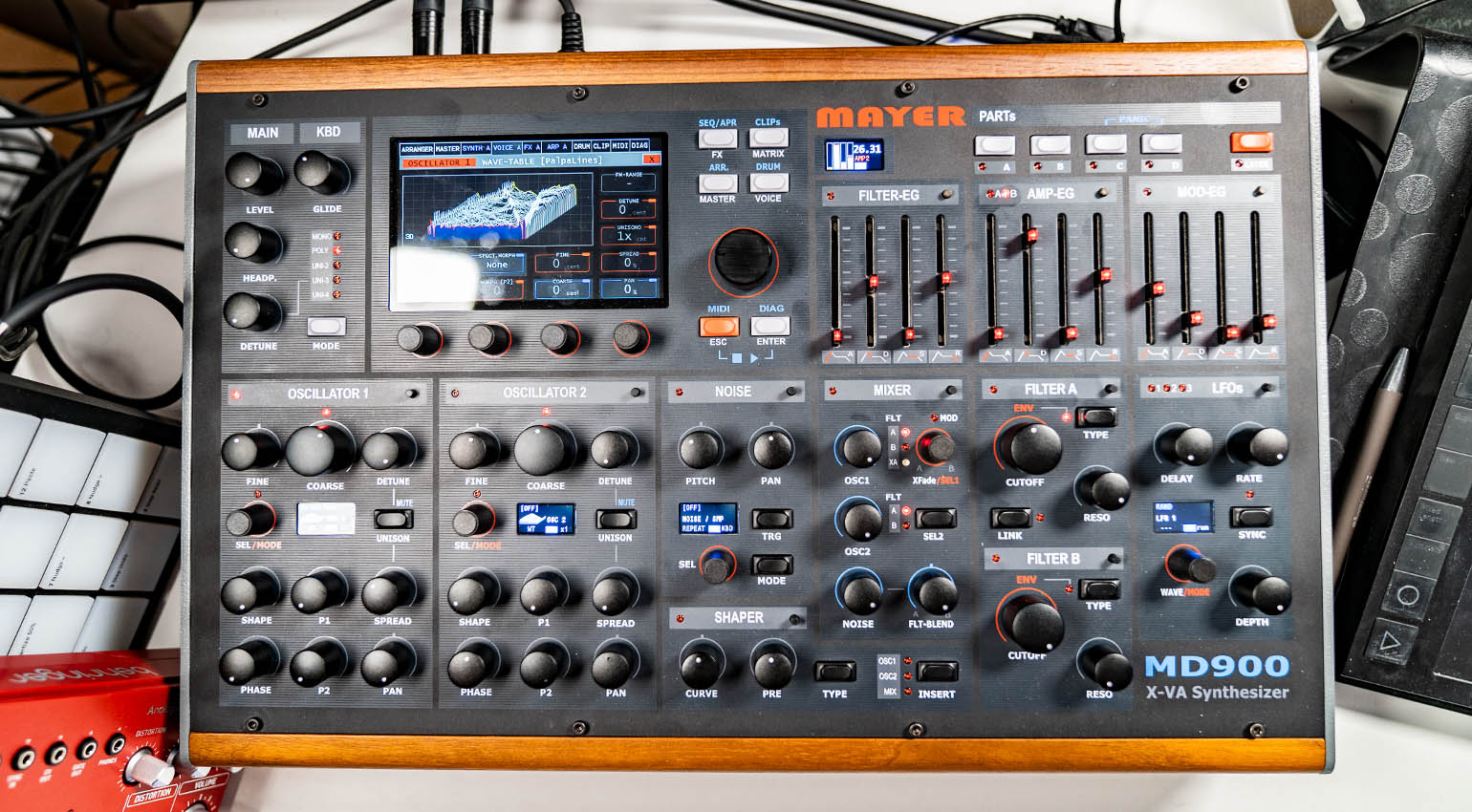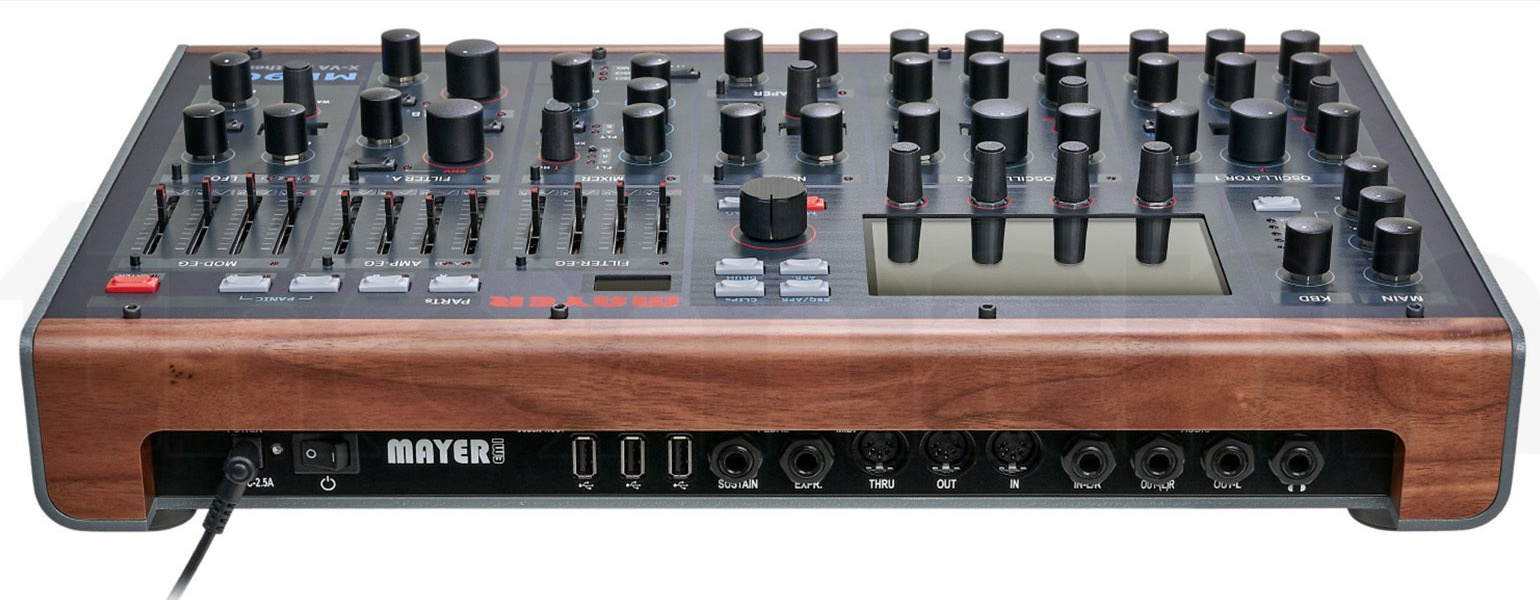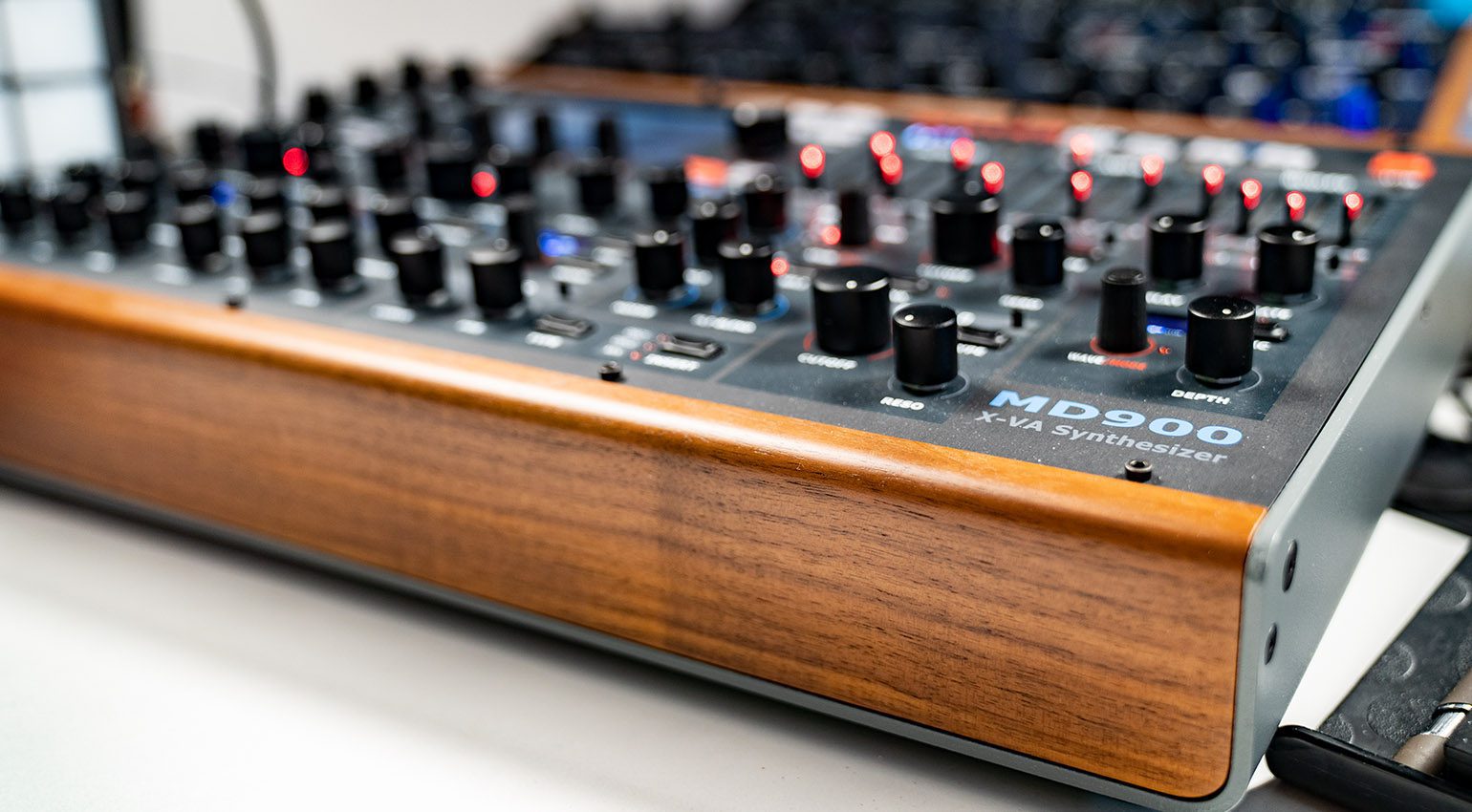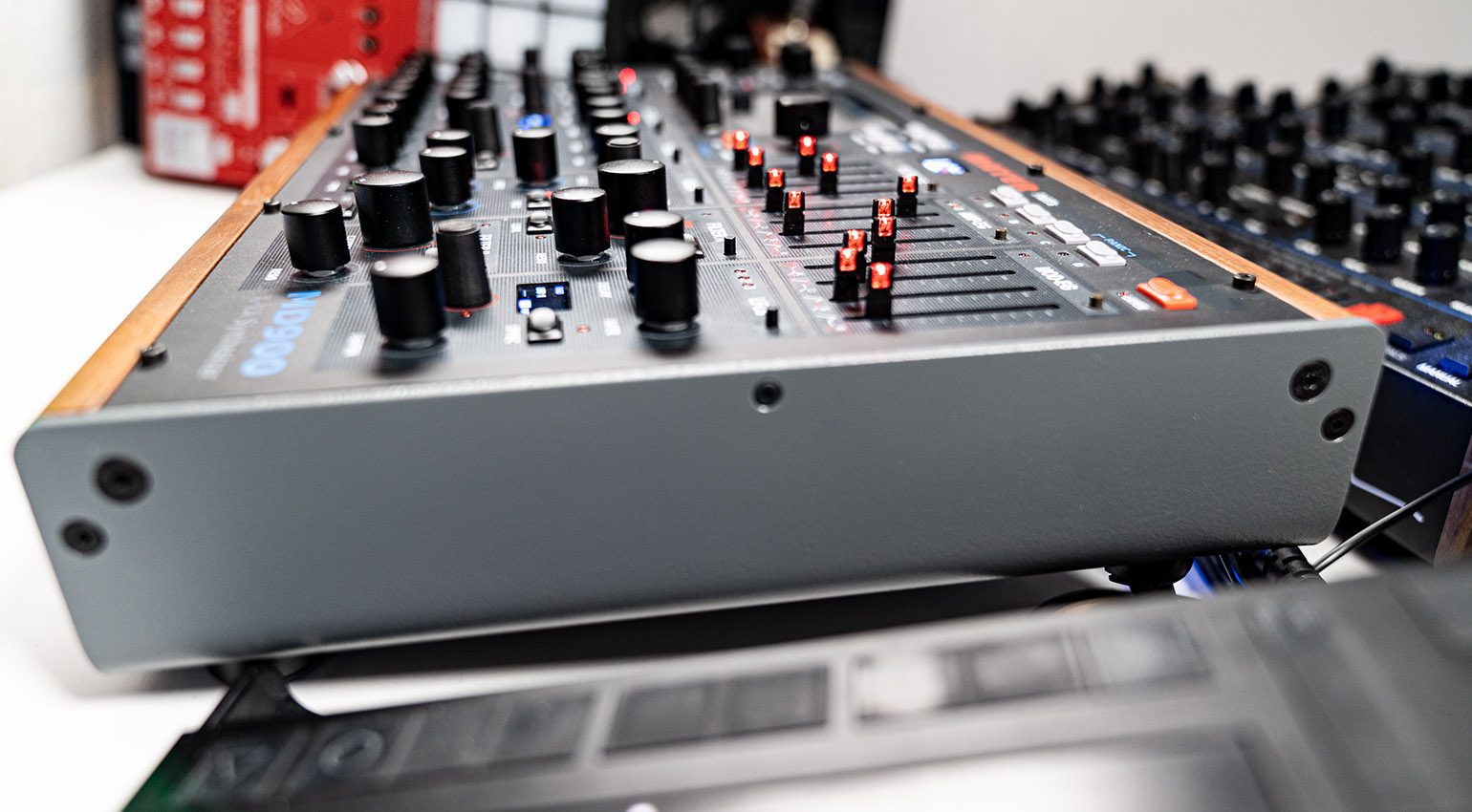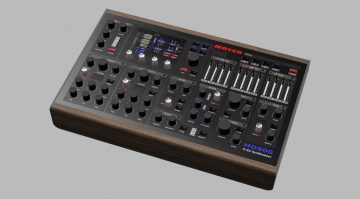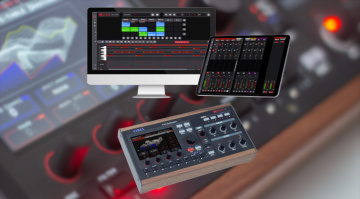Review: Mayer EMI MD900 XVA Desktop Synthesizer
At last year’s Superbooth, the Austrian developer Mayer EMI unveiled the MD900: an impressively versatile desktop synthesizer based on the M800-R2 Eurorack module. Meanwhile, the MD900 has arrived in the shops – and in our review studio. Here’s our first impression of this stunning synth from an independent developer.
Note: This article by Marcus Schmahl first appeared in German on gearnews.de.
Mayer EMI MD900 XVA Desktop Synthesizer
Horst Mayer, the man behind Mayer EMI, is a visionary developer whose captivating can-do attitude doesn’t just come through in conversations with him. It’s also evident in his instruments, above all the MD900 XVA. Every inch of this synth tells a story of hard work, determination, and years of experience. Just think about the courage it takes to take on such a project as a small independent company in times of component shortages, skyrocketing prices, and supply chain issues. For those of you who speak German, here’s my interview with Mr. Mayer:
You are currently viewing a placeholder content from Default. To access the actual content, click the button below. Please note that doing so will share data with third-party providers.
We’ve taken this extraordinary synthesizer through its paces for our review. During this whole time, we’ve been in touch with the developer, who had an answer or solution to any and all questions and problems. Through the company’s dedicated Discord channel, all users of the MD900 can benefit from the same level of support I enjoyed. Awesome!
Unboxing the Mayer MD900
The Mayer MD900 has a solidly made aluminum chassis with beautiful walnut sides. It weighs about 4.4 kg (or just under 10 lbs for the Americans) and sits firmly on my studio desk. Similar to the UDO Super 6 Desktop, the MD900’s enclosure has two little extendable feet for positioning it at a slight angle. The synthesizer measures 460 x 295 x 65 millimeters.
The impressive user interface consists of no less than 37 rotary knobs, ten clickable encoders, 23 buttons, 11 small buttons, 42 LEDs, and twelve faders. In addition to the main touchscreen, there are five smaller displays that keep you in the know about what’s going on in the various sections.
On the back, the Mayer MD900 features three USB-A ports for connecting controllers or the included USB flash drive, MIDI In/Out/Thru, sustain and expression pedal jacks, a stereo line input, two line outputs (L/R), and a headphone output. This is also where you’ll find the connector for the external power supply and the power switch.
After switching the synthesizer on, it takes about 20-25 seconds to boot. That’s because it needs to load the Linux-based operating system including all wavetables, samples, presets, and sub presets. You can follow the process on the various displays.
Mayer MD900 XVA sound engine
The 4-part multitimbral XVA sound engine with 16-voice polyphony is built around a Linux operating system with real-time extensions. Two oscillators and a noise generator are mixed and then sent to a pair of filters. There’s one envelope for the filter, two for the amps, and an extra one as an additional modulation source for sound shaping. In addition to this, the MD900 offers three LFOs with various waveforms and random generators for plenty of movement. The Shaper section wasn’t yet activated at the time of our review, but it’s coming soon.
The versatile oscillators are clearly the main event. In wavetable mode, they remind me a bit of the Serum software synthesizer. Each wavetable consists of 256 waves; if there are less than that in any given wavetable, the synth automatically generates additional waveform variants to expand the table to 256 waves. Moreover, each oscillator can run up to four instances, which is great for wide stereo spreads or fat, detuned sounds.
Hold the Mode button to switch to algorithm mode, in which the oscillators deliver standard waveforms like saw, sine, pulse, and variations of these. Additional algorithms include PWM, hard sync, and various formant and phase distortion modes. This mode covers all the basics and lends itself to classic, analog-style sounds. For the filters, you have a choice of various emulations (Moog Ladder, SEM, standard) and highpass, bandpass, and lowpass characteristics.
Effects
This solid foundation is rounded out by a massive effects section. Each part offers ten slots for effects like Mod-Delay (Flanger, Chorus, Vibrato), Param-EQ, Stereo Delay (Normal, Ping Pong), Moog Filter, Tube Amp, Reverb (Room, Hall, Large), Dynamics (sidechain compressor), and Phaser (6, 12, or 18 stages).
This powerful sound engine is obviously capable of an extremely wide range of sounds. Drones, pads, leads, organs, basses, FX, Reese basses, strings – there’s hardly anything the MD900 can’t do. It’s also pretty easy to use if you’re familiar with basic synthesis techniques. For a glimpse of what the Mayer sounds like, check out the Limbic Bits video at the bottom of this page.
An all-in-one music machine
In addition to the sound engine, the Mayer MD900 includes a sequencer and clip launcher that feels almost like a scaled-down version of Ableton Live. You can create MIDI clips in seven columns (4 synth parts, drums, CV1, CV2). An additional Master channel allows you to launch entire rows of clips simultaneously. Apart from recording MIDI using a connected keyboard, it’s also possible to import MIDI files via USB.
The first four columns correspond to the four synth parts, which can contain four different sounds. These parts share 16 voices. Clips can also include arpeggios or sequences, which are played back in sync with the tempo. Clips in the sixth and seventh columns are for controlling external devices via MIDI.
So what’s the drum column for, you ask? To round things out, the developer has integrated a drum sample player with 14 channels (Kick, Snare1, Snare2, Closed Hihat, Open Hihat, Ride, Crash, 3x Tom, 3x Percussion, plus one free slot). You can also load your own samples and program grooves using a drum grid editor on the touch display.
Operation
Thanks to its straightforward and logical panel layout, the Mayer MD900 is pretty easy to use straight out of the box. Everything is clearly labeled, so it’s easy to find your way around. The controls are precise and feel good to the touch, and the bright touchscreen feels snappy. Simply power it up, turn a few knobs, create some sounds, and make music – just the way it should be! On stage, the LEDs are quite helpful and the displays are easy to read, even at an angle.
If you’d like to dive deeper into the MD900’s sound design capabilities, you should definitely download the current manual from the developer’s website. It includes valuable information about things like shortcuts (like holding a button while turning another knob at the same time) and the more remote areas of the menu system.
To a bright future
I’ve spoken to Horst Mayer via Twitch and was able to elicit some interesting news. He’s constantly listening to user feedback and working on refining the synth, and thanks to the open platform, the possibilities are vast. In the near future, he plans to release a USB audio interface for the MD900, which will add additional audio outputs. That smells like multi-tracking and immersive audio!
Moreover, he’s thinking about adding a CV clock input (and maybe even additional CV inputs and outputs). We’ll keep you updated on this. In addition to this, the synth can be connected to a network (and the internet) using a USB LAN adapter, which enables things like remote servicing. Horst is also thinking about audio-over-LAN – exciting prospects!
The sequencer, modulation system, drum sampler, and audio inputs are also being worked on. Besides a sample morphing feature, there are plans to implement a vocoder. As you can see, the Mayer MD900 is far from finished, and it’ll continue to get better.
One thing that’s sadly missing is a USB port for connecting directly to a computer, but you can solve this problem using a LAN adapter (which costs about 10 bucks). You’ll also soon be able to access the file system via LAN, and import and export data via drag&drop. For the time being, data transfer can be accomplished using the included USB thumb drive. Another thing that’ll be addressed in an upcoming update is the response of the filter cutoff knob, which feels a bit sluggish at its current setting.
Conclusion
The Mayer EMI MD900 XVA Desktop Synthesizer is a highly versatile synth that looks and sounds fantastic. Despite its digital nature, it can absolutely hold its own against most analog synths in terms of sound, while offering greater flexibility and expandability thanks to the open architecture of the engine. The only limit is the available CPU power, but I didn’t encounter any problems with this during my review.
To sum up – this thing rocks! It’s obvious that the developer has put a great deal of thought into the features and workflow that musicians and sound designers really want. If you’re looking for a synth that’s capable of pretty much any sound you can imagine, the Mayer MD900 should definitely be on your list.
Price and availability
The Mayer EMI MD900 XVA Desktop Synthesizer is available at Thomann* for €3450.

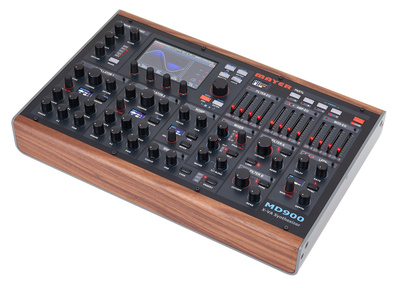
More information about the Mayer MD900
Videos
You are currently viewing a placeholder content from YouTube. To access the actual content, click the button below. Please note that doing so will share data with third-party providers.
You are currently viewing a placeholder content from YouTube. To access the actual content, click the button below. Please note that doing so will share data with third-party providers.
 5,0 / 5,0 |
5,0 / 5,0 | 

